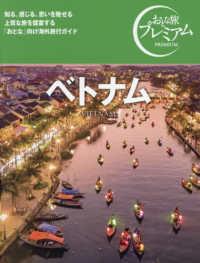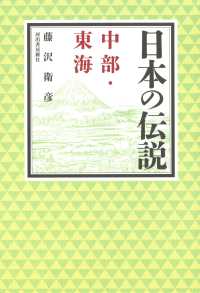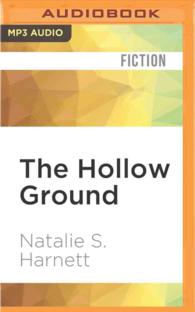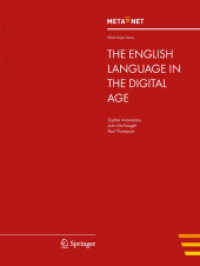- ホーム
- > 洋書
- > 英文書
- > History / World
基本説明
First published in German in 1938 and later translated into English, this classic of Italian Renaissance historiography centres on the relationship between Florentine art and the conditions under which it was created.
Full Description
First published in German in 1938 and later translated into English, this classic of Italian Renaissance historiography centres on the relationship between Florentine art and the conditions under which it was created. In rich detail, Martin Wackernagel explores the impact of patronage and function, widespread demand for art, workshop techniques, and businesses practices on artists' lives and the results they achieved
Wackernagel stresses the changing roles of commissions and patrons in the late fourteenth to the early fifteenth centuries, from small-scale enterprise under Lorenzo de Medici to the large-scale development of major Florentine monuments. Through this, he highlights the development of major civic and religious artistic complexes such as the Palazzo Vecchio, the Cathedral and Baptistery, and the convent of Santa Maria Novella. This volume also features a biography of the author and an essay on important later publications related to Wackernagel's themes and arguments.
Contents
Translator's Acknowledgments
Translator's Introduction
Abbreviations
Author's Preface
Author's Introduction
PART I The Commissions
CHAPTER 1 Great Projects and Work on Them from 1420 to 1530
The Duomo and Baptistery
The Church and Convent of Santa Maria Novella
The Palazzo Vecchio
CHAPTER 2 Sculptural Commissions
Sculpture for Church Buildings
Sculpture for Domestic Buildings
CHAPTER 3 Painting Commissions
Wall Painting and Stained Glass in the Interior of Churches and Convent Buildings
Panel Painting in Sacred Settings
Banners and Vestments
Paintings in Domestic Interiors
Household Paintings on Wood and Canvas
Painting on the Exterior of Buildings and Throughout the Cityscape
CHAPTER 4 Artistic Participation in the Staging of Public Festivities and Spectacles
PART II The Patrons
CHAPTER 5 The City Government and the Guilds
CHAPTER 6 Private Patronage in the Early and Mid-Quattrocento
Representatives of the First Stage of the Early Renaissance
Giovanni Rucellai and Cosimo de' Medici
Cosimo's Sons, Piero and Giovanni de' Medici
Attitudes and Forms of Patronage
CHAPTER 7 Lorenzo Magnifico, Piero di Lorenzo, and Lorenzo di Pierfrancesco de' Medici
CHAPTER 8 Patrons from the Medici Circle in Florence and the Netherlands: the Sassetti, Portinari, Tornabuoni, Filippo Strozzi, and Others
CHAPTER 9 Patrons of the High Renaissance and Extra-Florentine Commissioners and Collectors
CHAPTER 10 The General Attitude toward Art: The Public and the Artist
PART III The Artist's Workshop and the Art Market
CHAPTER 11 The Artist Class: Its Numerical Strength, Professional Organization, and Occupational Divisions
CHAPTER 12 Studios and their Working Procedures
Living and Working Places and the Organization of Work: Master, Assistants, and Apprentices
The Process of Sculpture
The Painter's Working Procedure: Drawing
Execution of Panel and Wall Paintings
The New Generation of Artists: Training for Apprentices and Assistants
CHAPTER 13 Business Practices in the Workshop and Art Market
Price Formation and Forms of Payment
Economic Status of Artists
CHAPTER 14 The Artists
Class Status and Class Consciousness
The Artist as a Person, his Social Circle, his Way of Life and Work
The Artistic Temperament and Range of Interests
The Artistic Type in Contemporary Society
Author's Bibliography
Translator's Bibliography
Index








